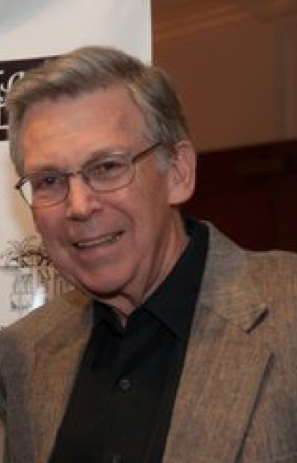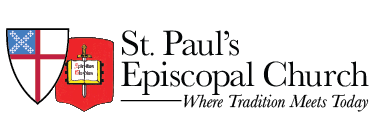 Kristen and I found our way to St. Paul’s and the Episcopal Church by way of Kristen’s sister Polly and her husband Peter Pook, members of St. Paul’s until they moved to Ontario several years ago. They asked us to join them at a service at 11:00 at which the chorus would make an unusual appearance, because at that time their usual service was at 9:30, when we had a regular tennis date with a good friend. So there was a family connection, the lure of good music, a compelling sermon by Chip Stokes, and (most of all) the congregation, many of whom we knew and all of whom radiated a welcoming happiness.
Kristen and I found our way to St. Paul’s and the Episcopal Church by way of Kristen’s sister Polly and her husband Peter Pook, members of St. Paul’s until they moved to Ontario several years ago. They asked us to join them at a service at 11:00 at which the chorus would make an unusual appearance, because at that time their usual service was at 9:30, when we had a regular tennis date with a good friend. So there was a family connection, the lure of good music, a compelling sermon by Chip Stokes, and (most of all) the congregation, many of whom we knew and all of whom radiated a welcoming happiness.
We were both raised as Catholics, and here I will take a turn to my own personal story. I lived in Winnetka, Illinois, with four siblings and wonderful parents who had an intellectually rich connection to their faith. Their library (we called it the “bookroom”) was amply stocked with the writings of the leading thinkers of the Catholic Church in the 1940s and 1950s. (I know they are still there, because of the good luck that my brother Michael still lives there with his wife Paula.) All of this led me naturally to take religion seriously as a subject of interest.
I went to a good Catholic grade school, taught by Dominican nuns who were a credit to their vocations. I heard rumors from time to time about Sister Whatsit who was mean and might even have slapped someone. But when I had her as a teacher (whoever she was), she was fine. Looking back, I recall hearing what I now recognize as doubtful legends about the childhood of Mary drawn from texts long ago judged to be apocryphal, but that was the way Catholicism was then and for centuries before. I also recall that, when I was around eleven, one or two of the sisters decided that I was called to be a priest. I am sure that this was because my religion was fostered by interesting conversations at home, and it showed up in the classroom.
This was a problem because I had looked forward to marrying and raising a family. But if God was calling me to the priesthood, didn’t that mean I had to enlist? The question haunted me as our curate, Father John Fahey, took me and three other boys for a tour of Mundelein Seminary, his Alma Mater, in a somewhat distant suburb of Chicago, with the evident aim of nurturing out interest in following the path he had taken. But he also provided the solution in one of his very good religion classes. He said that one of the most important signs of a vocation was that you actually wanted to be a priest. Problem solved! And kudos to a good priest!
In my years in Catholic high school and college, my relationship with the Church remained strong, moving to the more progressive wing of the Church that eventually dominated the Second Vatican Council in the early 1960s, the Council that moved the liturgy from Latin to English and that began to find more common cause with Protestantism and Judaism. At about age nineteen, I took out a subscription to the liberal Catholic magazine Commonweal, which I have renewed faithfully ever since, becoming a “Commoweal Catholic” and eventually joining its Board of Directors, where I still serve.
As the years went by, the Vatican cooled toward the direction taken by the Second Vatican Council, and I learned that many of the attractively advanced Catholic thinkers whose writing enriched my parents’ bookroom had been sporadically policed by conservative elements in the Vatican establishment, sometimes even threatened with excommunication. This followed a pattern that went back to some very bad behavior in the nineteenth century and before, in which the Church had aligned itself with some of the most reactionary and repressive forces in Europe. And it appeared that the pattern persisted, never having gone away. My profession as a teacher specializing in medieval literature led me to the study of the development of the centralized monarchical papacy, and I gradually came to the conclusion that it was an insoluble problem, insoluble even by good popes. The recurring sexual scandals and their connection with the Church’s policy of mandatory priestly celibacy only confirmed this conviction.
So I was ready for a change, but one that preserved a continuity with the best features of the Catholic Church. One of these was a highly developed liturgy that responded to the injunction of Jesus at the Last Supper to “do this in remembrance of me,” not just to listen to good sermons. This entailed a central place for the Eucharist, but with a favorable difference. The Catholic Church now seems to me to have taken a wrong turn about a thousand years ago in concentrating on the priestly act of changing the bread and wine into the body and blood of Christ rather than the transformative act of all the congregation in acting on Christ’s invitation to “take and eat” the Eucharist. This focus on an object rather than a collective act led, I think, to a fetishization of the bread and wine and to an unfortunate mystification of the priesthood as a special caste separate from the laity.
So I have found a spiritual home at St. Paul’s. In a country that wisely separates church and state, it improves upon the best tendencies of the modern Catholic Church and distances itself from the worst tendencies of the Borgia popes on the one hand and King Henry VIII on the other. The historical situation of the two churches in my life, the preservation of the good and the mitigation of the bad in each of them, seems to me to reveal the workings of the Holy Spirit turning all things to good in ways we struggle to understand.
